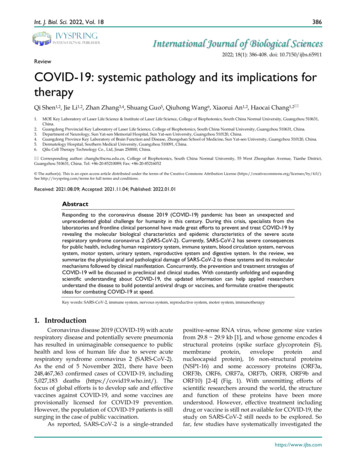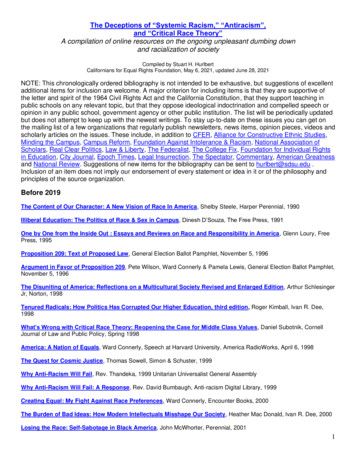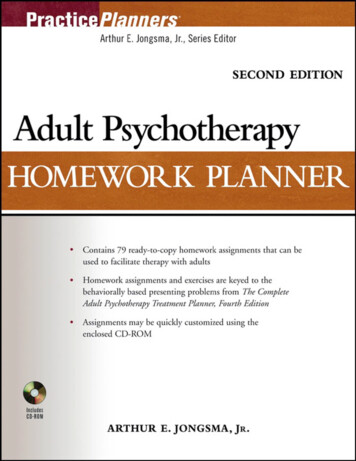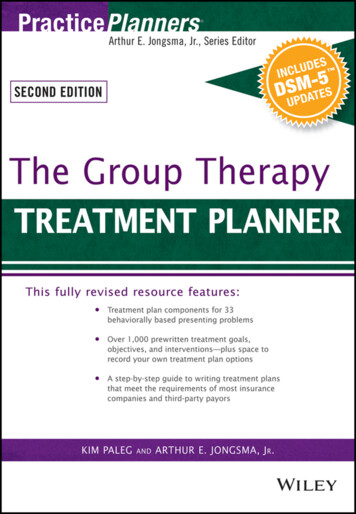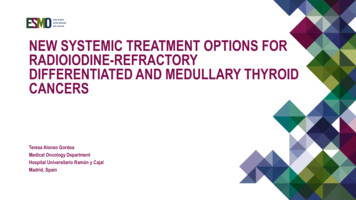
Transcription
NEW SYSTEMIC TREATMENT OPTIONS FORRADIOIODINE-REFRACTORYDIFFERENTIATED AND MEDULLARY THYROIDCANCERSTeresa Alonso GordoaMedical Oncology DepartmentHospital Universitario Ramón y CajalMadrid, Spain
INTRODUCTION TO DIFFERENTIATED (DTC)AND MEDULLARY (MTC) THYROIDCANCERSEpidemiologyHistologyMolecular BiologyRadioiodine Refractoriness in DTC
LEARNING OBJECTIVESTo better understand thegenetic landscape of thedifferent subtypes of thyroidcancer.To review the currenttreatment options for patientswith differentiated thyroidcancer (DTC) and medullarythyroid cancer (MTC)To improve the knowledgefrom the upcoming drugs forthe treatment of patients withDTC and MTC.
EPIDEMIOLOGYThyroid cancer represents 1% of all diagnosed tumours in adultsThyroid cancer isthe fifth mostcommon newcancer diagnosis inwomenThyroid cancer annual incidence increases from 2006 to 2010 and was 5.4% in men and 6.5% in women.The rate of death is also increasing from 1992 to 2010, although slightly, from 0.47 (per 100,000 population)to 0.50 among men and from 0.48 to 0.51 among womenSiegel R, et al. CA Cancer J Clin 2014;64:9–29. 2014 American Cancer Society, Inc. With permission from John Wiley & Sons, Inc.
EPIDEMIOLOGY: DTC AND MTCDifferentiated thyroid cancerRecurrent or metastatic disease: 7–23% (5% de novo)2/3 RAI- Refractory10-year overall survival:75–95% Stage I-II 50–60% Stage III-IV Hadoux J, et al. Lancet Diabetes Endocrinol 2016;4(1):64–71;Dadu R, Cabanillas ME. Minerva Endocrinol 2012;37:335–56;Cabanillas E, et al. Endocrine Reviews 2019; 40(6):1573–604.Medullary thyroid cancer50% N M At diagnosis: 4–17%At follow up 18–38%20% will die from progressive disease10-year overall survival:95% localised disease75% regional metastases40% distant metastases
HISTOLOGYDTC represents more than 90% of all thyroid cancersDifferentiated thyroid cancer 90%Medullary thyroid cancer 2%Anaplastic thyroid cancer 1%Lloyd RV, et al. WHO Classification of Tumours of Endocrine Organs. 4 th ed. Lyon: IARC; 2017Papillary (80%),Follicular (10–20%),Hürthle (2–8%),Poorly differentiated (2%)
HISTOLOGYThe new WHO classification (2017) has been conducted in concordancewith the genetic-molecular characterisation of these tumoursWHO classification for differentiated follicular-derived thyroid carcinomasTumour typeMorphologyMolecular markersEncapsulated, clear nuclei, no papillaeRAS, BRAF K601EPapillae and clear nucleiFollicles and clear nucleiSpecial structural and cell featuresBRAF V600E, RET/PTC fus, NTRK fus, ALK fus, 1q ampBRAF K601E, RAS, PAX8/PPARγ, EIF1AX, THADA fus, 22q delBRAF V600E, 1q amp, TERT promoter, TP53, PIK3CA, CTNNB1Follicular carcinomaCapsular invasion (MI), vascular invasion 4blood vessels (angioinvasive), extrathyroidalinvasion (WI)RAS, PAX8/PPARγ, PTEN, PIK3CA, TSHR, TERT promoter, CNAHürthle cell carcinomaCapsular invasion (MI), vascular invasion 4blood vessels (WI)RAS, EIF1AX, PTEN, TP53, CNA, mtDNAInvasion, mitoses 3, necrosis,#convoluted nucleiRAS, TERT promoter, TP53, PIK3CA, PTEN, CTNNB1, AKT1, EIF1AX,ALK fus, histone methyltransferases, SWI/SNF chromatin remodelingcomplexNIFTPPapillary carcinomaClassicalFollicular variantTall, columnar, solid, hobnail variantsPoorly differentiated carcinomaAmp, amplification; CNA, copy number alteration; del, deletion; fus, fusion; MI, minimally invasive; NIFTP, non-invasive follicular thyroid neoplasm with papillary-like nuclear features;SWI/SNF, switch/sucrose non-fermentable; WHO, World Health Organisation; WI, widely invasive.Filetti S, et al. Ann Oncol 2019;30:1856–83.
HISTOLOGYDominant signalling pathways associated with thyroid cancersMAPK pathway (e.g. via BRAFV600E)PTCFollicularthyroid cellMAPK pathway PI3K-AKT (e.g. via RAS, PTEN,PIK3CA mutations)MAPK pathway PI3K-AKT PDTCMAPK pathway PI3K-AKT ATCPI3K-AKT FTAFTCPI3K-AKT Model of the progression of thyroid tumorogenesis by the activation of MAPK and PI3K/AKT pathwaysthrough the accumulation of genetic alterationsXing M. Nat Rev Cancer 2013;13(3):184–99
MOLECULAR BIOLOGY: DTCIntegrated genomic characterisation of papillary thyroid carcinoma (PTC)Key messages from the genomic analysis of496 PTC:80% of driver genetic alterations involve3 genes: BRAF, RAS (NRAS, KRAS) andRETDark matter reduction from 25% to 3%Novel genetic aberrations in known genes(BRAF fusions)Novel genes with driver alterations (TERT,CHEK2, PPM1D, EIF1AX)Low proportion of copy number alterations(27.2%), more frequent in follicular variantLow somatic mutation density (average:0.41 nonsynonymous mutations per Mb) Reprinted from Cell, 159(3), The Cancer Genome Atlas Research Network, Integrated Genomic Characterization of Papillary Thyroid Carcinoma, 676–90.Copyright 2014, with permission from Elsevier.
MOLECULAR BIOLOGY: PTCSignalling and differentiationReprinted from Cell, 159(3), The Cancer Genome Atlas Research Network, Integrated Genomic Characterization of Papillary Thyroid Carcinoma, 676–90.Copyright 2014, with permission from Elsevier.
MOLECULAR BIOLOGY: PTCSignalling and differentiation Results in profound phenotypic differencesBRAF-likeRAS-likeHigh MAPKMAPK and PI3K/AKT(p90RSK as a crucial crossroad)BRAF V600E, RET fusions, BRAF fusionsNRAS, HRAS, KRAS, EIF1AX, PAX8/PPARClassical, tall cellFollicularLow/HeterogeneousHighHighLowmiR-21, miR-146b, miR-204, miR-221/222miR-183-5p, miR-182-5pSignallingGenetic alterationsHistological variantsDifferentiationRisk of recurrencemiRNAThe Cancer Genome Atlas Research Network. Cell 2014;159:676–90
MOLECULAR BIOLOGY: MTCThe main driver mutations are RET and RASRET activation leads to the activation of the MAPK and PI3K pathways that regulate cell proliferation and survivalGermline RET mutations: MTC is associated with familial syndromes in 30% of patientsMEN2A phenotype is linked to mutations in RET cysteine codons in exons 10 and 11MEN2B phenotype is almost exclusively associated with the Met918Thr alteration in exon 16Somatic RET mutations: reported in 50% of patients with sporadic MTCThe most common alteration is Met918Thr in exon 16 RAS activation has been reported in 10–45% of patients with sporadic MTC (more commonly HRAS and KRAS) andin 80% of patients RET-negative sporadic MTCVEGFR, MET and FGFR are overexpressed in MTC.Bible KC, Ryder M. Nat Rev Clin Oncol 2016;13(7):403–16.
MOLECULAR BIOLOGY: SPORADIC VS. HEREDITARY SMoura M, et al. J Clin Endocrinol Metab 2011;96:863–8;Agrawal N, et al. J Clin Endocrinol Metab 2013;98:364–9;Ciampi R, et al. Thyroid 2013;23:1–4.NRASFigure courtesy of Dr Alonso, based on de Groot JWB, et al. Endocr Rev2006;27(5):535–60.
MOLECULAR BIOLOGY: MTCIntracellular signalling pathways activated by RETFigure courtesy of Dr Alonso, based on de Groot JWB, et al. Endocr Rev 2006;27(5):535–60.
SYSTEMIC TREATMENT FOR RAI-DTCAND MTCLenvatinib and SorafenibVandetanib and CabozantinibRET inhibitors: Pralsetinib, SelpercatinibOther novel therapeutic strategies
SYSTEMIC TREATMENTIn thyroid cancer, some signalling pathways have shown potential therapeutic relevanceReprinted by permission from Springer Nature, Nat Rev Clin Oncol, Evolving Molecularly Targeted Therapies for Advanced-Stage Thyroid Cancers, Bible KC, Ryder M. Copyright 2016.
SYSTEMIC TREATMENTApproved drugs in DTC and SELPERCATINIB*SELPERCATINIB**FDA approval (May 2020) for adult and pediatric patients 12 years of age with advanced or metastatic RET-mutant MTC or RET-fusion RAI-DTC who require systemic yroid-cancers-ret-gene-mutations-or-fusions
SYSTEMIC TREATMENT FOR DTCESMO Clinical Practice GuidelinesRecommendations formanagement of RAIrefractory, advanced/metastatic DTC patientsAnn Oncol 2019;30:1856–83. Reprinted from Ann Oncol , 30, Filetti S, et al. Thyroid cancer: ESMO Clinical Practice Guidelines for diagnosis, treatment and follow-up, 1856–83,Copyright 2019, with permission from Elsevier.
SYSTEMIC TREATMENT FOR RAI-DTC: SORAFENIBN 417 Locally advanced or metastatic,RAI-refractory DTC Progression (RECIST) within theprevious 14 monthsSorafenib400 mg orally twice dailyRandomisation1:1 No prior chemotherapy, targetedtherapy, or thalidomide Progression-free survivalSecondary endpoints Overall survivalPlaceboOrally twice dailyStratified by:Geographical region (North America or Europe or Asia)Age ( 60 or 60 years)Progression assessed by independent central review every 8 weeksAt progressionPatients on placebo allowed to cross over at the investigator’s discretionPatients on sorafenib allowed to continue on open-label sorafenib at the investigator’s discretionBrose M, et al. Lancet 2014;384(9940):319–28Primary endpoint Response rate Safety Time to progression Disease control rate Duration of response Sorafenib exposure (AUC0-12)
SYSTEMIC TREATMENT FOR RAI-DTCmPFS 10.8 m (S) vs. 5.8 m (P); HR 0.59 (95% CI: 0.45, 0.76; p 0.0001)Reprinted from The Lancet, 384(9940), Brose M, et al. Sorafenib in Radioactive Iodine-Refractory, Locally Advanced or Metastatic Differentiated Thyroid Cancer: A Randomised, DoubleBlind, Phase 3 Trial, 319-28, Copyright 2014, with permission from Elsevier.
SYSTEMIC TREATMENT FOR RAI-DTCOther secondary efficacy endpointsSorafenibn (%)Placebon (%)19620124 (12.2)1 (0.5) 0.000100—24 (12.2)1 (0.5)—Stable disease for 6 months82 (41.8)67 (33.2)—Disease control rate(CR PR SD 6 months)106 (54.1)68 (33.8) 0.000110.2 (7.4–16.6)NA—Total evaluable patientsResponse rateComplete responsePartial responseMedian duration of response (PRs) months (range)Brose M, et al. Lancet 2014;384(9940):319–28P-value
SYSTEMIC TREATMENT FOR RAI-DTCSafetyAE, %aHand-foot skin ight lossHypertensionMetabolic/lab (other)bSerum TSH increasebAnorexiaOral gentSorafenib (n 207)Any GradeGrade o (n 209)Any GradeGrade 3.404.803.3010.5011.504.81.5adverse events occurring in 10% of patients in either arm during the double-blind period (safety population); bTSH levels 0·5 mIU/L are included within this NCICTCAE term and blood TSH increase (MedDRA v15·1 term) is also reported.Brose M, et al. Lancet 2014;384(9940):319–28.
SYSTEMIC TREATMENT FOR RAI-DTC: LENVATINIBPatients with DTC(N 392) IRR evidence ofprogression withinprevious 13 months 131I-refractory Measurable disease Stratification diseaseUp to 1 prior VEGF orVEGFR-targeted therapy Geographic region(Europe, N. America,other)Prior VEGF/VEGFRtargeted therapy (0,1)Lenvatinib (n 261)24 mg daily PORandomisation 2:1Primary endpoint PFSSecondary endpoints ORR OS SafetyAge ( 65 years, 65years)Placebo (n 131)24 mg daily POTreatment until disease progressionconfirmed by IRR (RECIST v1.1)Schlumberger M, et al. N Engl J Med 2015;372:621–30Lenvatinib(Optional, open-label)
SYSTEMIC TREATMENT FOR RAI-DTCmPFS 18.3 m (L) vs. 3.6 m (P); HR 0.21 (99% CI: 0.14, 0.31; p 0.001)From N Engl J Med, Schlumberger M, et al. Lenvatinib Versus Placebo in Radioiodine-Refractory Thyroid Cancer, 372, 621–30. Copyright 2015 Massachusetts Medical Society.Reprinted with permission from Massachusetts Medical Society.
SYSTEMIC TREATMENT FOR RAI-DTCOther secondary efficacy endpointsTreatment group: LenvatinibTreatment group: PlaceboORR 64.8% (L) vs. 1.5% (P)OR 28.87 (95% CI: 12.46, 66.86; p 0.001)From N Engl J Med, Schlumberger M, et al. Lenvatinib versus Placebo in Radioiodine-Refractory Thyroid Cancer, 372, 621–30. Copyright 2015 Massachusetts Medical Society.Reprinted with permission from Massachusetts Medical Society.
SYSTEMIC TREATMENT FOR RAI-DTCLenvatinib (n 261)Adverse Event, %Placebo (n 131)Any GradeGrade 3Any GradeGrade 3Hypertension684292Diarrhoea60880Fatigue / asthenia599282Decreased appetite505120Nausea / vomiting463151Decreased weight461090Stomatitis36440Palmar-plantar erythrodysesthesia ia24130Schlumberger M, et al. N Engl J Med 2015;372:621–30
SYSTEMIC TREATMENT FOR RAI-DTCAdverse eventsSorafenibLenvatinibDose reduction133 (64.3%)177 (68%)Dose interruption137 (66.2%)215 (82%)Discontinuation of treatment39 (18.8%)37 (14%)1 (0.4%)6 (2%)Fatal AE n (n 1)Brose M, et al. Lancet, 2014;384(9940):319–28Schlumberger M, et al. N Engl J Med 2015;372:621–30Pulmonary embolism (n 1)Hemorrhagic stroke (n 1)General health deterioration(n 4)
SYSTEMIC TREATMENT FOR RAI-DTCThe mutational status BRAF/RAS does not have a role as a predictive factor.SELECTtrialLenvatinibPlaceboBRAF NE4.3 monthsHR 0.17BRAF–18.3 months1.9 monthsRAS NERAS–18.3 monthsDECISIONtrialSorafenibPlaceboBRAF 20.5 months9.4 monthsHR 0.46HR 0.15BRAF–8.9 months3.8 monthsHR 0.555.6 monthsHR 0.12RAS 5.5 months3.4 monthsHR 0.492.4 monthsHR 0.20RAS–10.8 months5.7 monthsHR 0.60All patients benefited from Lenvatinib orsorafenib regardless of mutational statusBrose M, et al. Lancet, 2014;384(9940):319–28 ;Schlumberger M, et al. N Engl J Med 2015;372:621–30.
SYSTEMIC TREATMENT FOR MTCESMO Clinical Practice GuidelinesRecommendations for management of MTC patientsAnn Oncol 2019;30:1856–83. Reprinted from Ann Oncol , 30, Filetti S, et al. Thyroid cancer: ESMO Clinical Practice Guidelines for diagnosis, treatment and follow-up, 1856–83,Copyright 2019, with permission from Elsevier.
SYSTEMIC TREATMENT FOR MTC: VANDETANIBUnresectable locallyadvanced/metastaticHereditary/SporadicWHO PS 0-2Calcitonin 500 pg/mLN 331VANDETANIB 300 mg/24 hrN 231 (RET 137)Disease progressionRandomisation 2:1PLACEBON 100 (RET 50)Open-label treatment withvandetanibPrimary endpoint: Progression-free survivalSecondary endpoints: Objective response rate, disease control rate at 24 weeks, duration of response, overall survival,biochemical response (decreases in CTN and CEA), time to worsening of painWells S, et al. J Clin Oncol 2012;30:134–41
SYSTEMIC TREATMENT FOR MTCPFS 19.3 m vs. NR (estimated 30.5 m); HR 0.46 (95% CI: 0.31, 0.69; p 0.001)Wells S, et al. J Clin Oncol 30, 2012:134–41. Reprinted with permission. 2012 American Society of Clinical Oncology. All rights reserved.
SYSTEMIC TREATMENT FOR MTCForest plot of HR for PFS according to RET mutation status andM918T mutation status in sporadic MTCIn patients with sporadic MTC: RET mutation-positive (M918T)patients show a benefit in PFS andRR with vandetanibSmall number of patients RETmutation-negative and large numberof RET mutation-unknown subgroup analysis of PFS and RRresulted inconclusiveRR 54.5%RR 30.9%Wells S, et al. J Clin Oncol 30, 2012:134–41. Reprinted with permission. 2012 American Society of Clinical Oncology. All rights reserved.
SYSTEMIC TREATMENT FOR MTC: CABOZANTINIBUnresectable locallyadvanced/metastatic MTC withdocumented RECIST progressionwithin previous 14 monthsN 330Cabozantinib 140 mg/24 hrn 219Randomisation 2:1Placebon 111PROGRESSION FREE SURVIVALDisease progression permRECISTor deathPrimary endpoint: Progression-free survival mRECIST determined by IRCSecondary endpoints: Overall survival, objective response rate and assessment of the relationship between RET mutationstatus and efficacy of cabozantinibElisei R, et al. J Clin Oncol 2014;32(17):1864;Schlumberger M, et al. Ann Oncol 2017;28:2813–9.
SYSTEMIC TREATMENT FOR MTCPFS 11.2 m vs. 4.0 m; HR 0.28 (95% CI: 0.19, 0.40; p 0.001)Elisei R, et al. J Clin Oncol 32(17), 2014:1864. Reprinted with permission. 2014 American Society of Clinical Oncology. All rights reserved.
SYSTEMIC TREATMENT FOR MTCSubgroup analysis of OS and PFS according to RET mutation status, RET M918T status,and RAS mutations statusCabozantinib was favoured over placebo for both OS and PFS in patients with and without RET mutations and forthose with an unknown RET mutation statusSchlumberger M, et al. Ann Oncol 2017;28:2813–9. Reproduced under the terms of the Creative Commons Attribution Non-Commercial License (http://creativecommons.org/licenses/bync/4.0/; accessed July 2020),
SYSTEMIC TREATMENT FOR MTCPHASE 3 ctable locally advanced/metastaticDocumented RECIST progression56% (187) / 2.4% (8) / 41% (136)48% (159) / 12% (41) / 39% (130)ORR45% vs. 13%28% vs. 0%DCR87% vs. 71%55.3% vs. 13.5%Calcitonin69% vs. 3% (p 0.001)–45.2% vs. 57.2% (p 0.001)CEA52% vs. 2% (p 0.001)-23.7% vs. 88.7% (p 0.001)PFSNR (predicted median 30.5 months) vs. 19.3 months (HR 0.27)11.2 months vs. 4.0 months (HR 0.28)OSHR 0.83 (95% CI: 0.60, 1.14)HR 0.85 (95% CI: 0.64, 1.12)Diarrhoea, hypertension, QTc prolong, fatigueDiarrhoea, PPE, hypertension fatigue12% vs. 3%16% vs. 8%NTreatmentInclusion criteriaRET / RET– / RET unknownAdverse events G3Discontinuation due to AENR, not reached; PPE, palmar-plantar erythrodysesthesia.1. Wells S, et al. J Clin Oncol 2012;30:134–41;2. Schlumberger M, et al. Ann Oncol 2017;28:2813–9.
SYSTEMIC TREATMENT FOR MTC: OTHER ase IIPhase IIPhase IIPhase II11 (60 DTC MTC)16 5 (S H)2591-10/12 5/511/13 (85%)33/47Doses5 mg/12 hr400 mg/12 hr50 mg/24 h 4/2125 mg/24 hr x 48 wkResponse(PR/SD)2/3 (45%)1 1/8 1 (52%)8/13 (92%)2/44 (50.5%)18(DTC MTC)17.9-12HTN, fatigue, GI,anorexia, proteinuriaDiarrhoea, oral pain,PPE, alopecia, HTNAsthenia, GI, PPE,Neu, LinfDiarrhoea, HTN,fatigue, anorexiaStudyNRET mutation statusPFS (months)Adverse eventsPPE, palmar-plantar erythrodysesthesia.1. Cohen EE, et al. J Clin Oncol 2008;26; 4708–13; 2. Lam ET, et al. J Clin Oncol 2010;28;2323–30;3. De Souza JA, et al. ASCO 2010; Abstr 5504; 4. Schlumberger MJ, et al. J Clin Oncol 2009;27;3794–801.
NEW DRUGS IN THE FIELD OF DTC AND MTC:RET INHIBITORSRET mutations in MTCs:M918T 70.5%C634R 4.9%A993F 2.2%C634Y 2.1%C634W 1.9%C630R 1.5%E632 L633 del 1.4%D999 E901 del 1.4%C620R 0.6%S991A 0.6% RET rearrangements occurin up to 10–20% of PTCs:CCDC6 59%NCOA4 36% Reprinted from Cancer Discov 2020;10:498–505, Subbiah V & Cote GJ. Advances in Targeting RET-Dependent Cancers, with permission from AACR;Subbiah V, et al. J Clin Oncol 2020;38:1–14.
DEVELOPMENT OF RET INHIBITORS IN THYROID CANCERPreclinical and clinical activity, IC50, and efficacy of multikinase versusselective RET Inhibitors in MTCIC50, 8-100BLU-6670.40.40.30.40.435DrugSubbiah V, et al. J Clin Oncol 2020;38:1-14.
DEVELOPMENT OF RET INHIBITORS IN THYROID CANCERLIBRETTO – 001: Phase 1/2 trial in patients with RET-altered cancersTotal enrolledn 531Phase 1 dose escalationSelpercatinib dosed at20 mg QD-240 mg BIDRET-mutant medullarythyroid cancern 226RET fusion-positivethyroid cancern 27Phase 2 dose escalationSelpercatinib dosed at160 mg BIDRET fusion-positiveNSCLCn 253Prior carbozantiniband/or vandetanibn 214Cabozantinib/vandetanib-naïven 88Non-measurable diseasen 14Othern 25Wirth L, et al. Ann Oncol 2019:30 (suppl 5):v933. Presented at ESMO; abstract LBA93; with permission from Dr L. Wirth.Primary analysis setn 55First 55 patients withRET-mutant MTC whohad received priorcabozantinib and/orvandetanib*RedrawRET alteration Determined by localCLIA (or similarlyaccreditedlaboratories)Primary endpoint Objective responserate (RECIST 1.1)Secondary endpoints Duration of response PFS SafetyTreatment beyondprogression permittedwith continued benefit
DEVELOPMENT OF RET INHIBITORS IN THYROID CANCERLIBRETTO – 001: Activity of selpercatinib in RET-mutant MTC primary analysis set (N 55)Investigator response assessments as of June 17, 2019. Total % may be different than the sum of the individual due to rounding.Wirth L, et al. Ann Oncol 2019:30 (suppl 5):v933. Presented at ESMO; abstract LBA93; with permission from Dr L. Wirth. .
DEVELOPMENT OF RET INHIBITORS IN THYROID CANCERLIBRETTO – 001: Activity of selpercatinib in RET fusion-positive thyroid cancer (N 26)Investigator response assessments as of June 17, 2019. Total % may be different than the sum of the individual due to rounding.Wirth L, et al. Ann Oncol 2019:30 (suppl 5):v933. Presented at ESMO; abstract LBA93; with permission from Dr L. Wirth. .
DEVELOPMENT OF RET INHIBITORS IN THYROID CANCERLIBRETTO – 001: Updated results from selpercatinib in RET-mutant MTC and RET fusion TCShah M, et al. J Clin Oncol 38:2020 (suppl; abstr 3594) Courtesy of Dr M Shah.
DEVELOPMENT OF RET INHIBITORS IN THYROID CANCERARROW STUDY: a Phase 1 dose followed by a Phase 2 expansion (400 mg QD) in patients withadvanced RET-altered solid tumoursPhase 2 study design RET fusion-positive NSCLCAdvanced solid tumoursRET-altered (localtesting)No other drivermutationsPrimary endpointsRET mutation-positive MTC ECOG PS 0-1Pralsetinib dosing:400 mg PO QDSubbiah V, et al. J Clin Oncol 38:2020 (suppl; abstr 109) RET fusion-positiveother tumoursCentrally reviewedORR per RECIST v1.1Safety
DEVELOPMENT OF RET INHIBITORS IN THYROID CANCERARROW STUDY: a Phase 1 dose followed by a Phase 2 expansion (400 mg QD) in patients withadvanced RET-altered solid tumoursDTC (N 11)MTC (N 49)All RET mutant MTC patients (400 mg QD)per central radiology74% ORR* in treatment naïve RET-mutated MTCand 60% ORR‡ in those previously treatedData reported on April 1, 2020.Subbiah V, et al. J Clin Oncol 38:2020 (suppl; abstr 109); with persmission from Dr V Subbiah.
DEVELOPMENT OF RET INHIBITORS IN THYROID CANCERSafetySelpercatinib:1The most frequent treatment-related AEs ( 15%) dry mouth (33%), increased AST (26%), hypertension (24%),increased ALT (25%), diarrhoea (22%) and fatigue (18%)Pralsetinib:2The most frequent treatment-related AEs ( 15%) were anaemia (33%), increased AST (33%), decreased WBCcount (33%), hypertension (30%), increased ALT (26%), hyperphosphatemia (19%) and neutropenia (19%)1. Shah M, et al. J Clin Oncol 38:2020 (suppl; abstr 3594);2. Subbiah V, et al. J Clin Oncol 38:2020 (suppl; abstr 109).
NTRK INHIBITORS IN THYROID CANCERNTRK1-3 (Neurotrophic Tyrosine Receptor Kinase): Encoding for transmembrane TropomyosinReceptor Kinase: TRKA, TRKB, TRKC.Physiologic functions: Differentiation and survival ofneurons, synapse formation and plasticity, membranetrafficking, formation of axons and dendritesNTRK gene fusions are targetable genetic alterations thatcode for fusion proteins that lead constitutive activation ofsignalling pathwaysThyroid cancer has a frequency of TRK fusions between5–25%First-generation TRK inhibitors: Larotrectinib and entrectinibReprinted by permission from Springer Nature, Nat Rev Clin Oncol, NTRK fusion-positive cancers and TRK inhibitor therapy, Cocco E, et al. Copyright 2018;Kummar S. Target Oncol 2018;13:545–56; Drilon A, et al. N Engl J Med 2018;378:731–9; Drilon A, et al. Cancer Discovery 2017;7:400–9
NTRK INHIBITORS IN THYROID CANCERENTRECTINIB:1 Analysis of three Phase 1/2 trialsN 54 (Thyroid n 5)LAROTRECTINIB:2 Analysis of three Phase 1/2 trialsN 153 (Thyroid n 24)ORR 57% (CR 7%)PD 7%mPFS 11.2 months (8.0, 14.9)ORR 79% (CR 16%) Thyroid (ORR 79%)PD 6%mPFS 18.3 months (22.1, NE)1. Reprinted from Lancet Oncology, 21(2), Doebele RC, et al. Entrectinib in patients with advanced or metastatic NTRK fusion-positive solid tumours: integrated analysis of three phase1–2 trials, 271–82. Copyright 2020, with permission from Elsevier; 2. Reprinted from Lancet Oncol, 21(4), Hong DS, et al. Larotrectinib in patients with TRK fusion-positive solidtumours: a pooled analysis of three phase 1/2 clinical trials, 531–40. Copyright 2020 with permission from Elsevier.
REDIFFERENTIATION THERAPY IN THYROID CANCER (DTC)NIS (sodium iodide symporter) mediates radioiodine uptake intothyroid normal and cancer cellsAlterations in RTK/BRAF/MAPK/ERK and PI3K/AKT/mTORpathways underly the diminished NIS signaling; key in RAIrefractoriness.Kinase inhibitors have been shown to re-induce iodide uptakein RAI-refractory thyroid cancer cellsAashiq M, et al. Cancers 2019;11:1382–97. Reproduced under the terms of the Creative Commons Attribution License (https://creativecommons.org/licenses/by/4.0/; accessed July 2020)
REDIFFERENTIATION THERAPY IN THYROID CANCER (DTC)1. Selumetinib 75 mg/12 h x 4 wTumour genotypePatients with increased iodine uptakein a lesion after selumetinibPatients who receivedradioiodineNo./Total no. of 1/31/312/208/20Total UptakeN 10 BRAF-mutated RAI PTCResponse (RECIST 1.1)2. Dabrafenib 150 mg/12 h x 25 dBaselineAfter selumetinibNo uptakeThis strategy is currently under research:NCT01947023: Dabrafenib LapatinibNCT03244956: Dabrafenib TrametinibPatient1. From N Engl J Med, Ho AL, et al. Selumetinib-Enhanced Radioiodine Uptake in Advanced Thyroid Cancer, 368:623–32; Copyright 2013 Massachusetts Medical Society. Reprinted withpermission from Massachusetts Medical Society; 2. Reprinted from Clin Cancer Res 2015;21(5):1028–35, Rothenberg SM, et al. New systemic treatment options for radioiodine refractorydifferentiated and medullary thyroid cancers, with permission from AACR.
IMMUNOTHERAPY IN THYROID CANCERRationale in thyroid cancerAntithyroid antibodies are present in 18–40% of patients with PTCRecruitment of mast cells has been related with dedifferentiation, invasion and angiogenesis through production ofchemokines or interleukinTregs have been identified in large amounts in DTC and ATC, associated with tumour aggressivenessTumour-associated macrophages (TAM): Presence of M2 TAM in DTC were associated with invasion and poorprognosisImmune profiling of BRAF-V600E-positive DTC compared with BRAF wild-type tumours:High levels of PD-L1 (53% vs. 12.5%)High levels of HLA G (41% vs. 12.5%)High levels of suppressive T cell and macrophage components Angell TE, et al. Thyroid 2014;24:1385–93;Naoum GE, et al. Molecular Cancer 2018;17(1):51.
IMMUNOTHERAPY IN THYROID CANCERImmunotherapy trials addressing thyroid cancer: Phase Ib KEYNOTE-028 trialPembrolizumab in Papillary and Follicular thyroid cancer (N 22)ORR 2%Clinical Benefit Rate 50% (95% CI: 28, 72)SD 6 months 69% (95% CI: 39, 91)Mehnert JM, et al. BMC Cancer 2019;19(1):196. Reproduced under the terms of the Creative Commons Attribution 4.0 International License ed July 2020).
IMMUNOTHERAPY IN THYROID CANCERImmunotherapy trials addressing thyroid cancerNCT IDENTIFIERTARGETTREATMENTNCT01346358TAMCSF-1R inhibitorNCT01525602TAMCSF-1R inhibitor paclitaxelNCT01856920Dendritic cellsGI-6207 (vaccine targeting CEA in MTC)NCT02239861Dendritic cellsSpecific adoptive cytotoxic T cells targeting several tumour antigens(NY-ESO-1, MAGEA4, PRAME, surviving, SSX)NCT02054806T cellsPembrolizumabNCT02452424TAMCSF-1R inhibitor pembrolizumabNCT02718911TAMCSF-1R inhibitor tremelimumab durvalumabNCT03753919T cellsTremelimumab durvalumabNCT02501096T cellsLenvatinib pembrolizumabNCT01988896T cellsCobimetinib atezolizumabNCT01656642T cellsVemurafenib atezolizumabNaoum GE, et al. Molecular Cancer 2018;17(1):51.
NOVEL DRUGSMAPK and PI3K pathways cross talk and tumour escape mechanismTargeting ERBB-HER2/3SSTR targetingLapatinib dabrafenib(NCT01947023)Neratinib (NCT03065387)177-Lu-PP-F11N(NCT02088645)Targeting ALK translocationsCeritinib (NCT02289144)Targeting mTORSorafenib everolimus(NCT02143726)MEK targetingSelumetinib (NCT01843062)Dabrafenib trametinib(NCT02034110)Naoum GE, et al. Molecular Cancer 2018;17(1):51. Reproduced under the terms of the Creative Commons Attribution 4.0 International ; accessed July 2020).
CONCLUSIONSThyroid carcinoma is a heterogeneous disease, but the advances in understanding the genomic landscapehave helped in the development of novel drugsMultikinase inhibitors that block VEGFR signalling have demonstrated benefit for DTC and MTC in Phase 3 trials,such as sorafenib, lenvatinib, cabozantinib and vandetanibThe scenario of thyroid cancer treatment is rapidly changing with the role of RET inhibitors, such as pralsetiniband selpercatinibOther promising targets are under research based on the molecular biology of thyroid cancer andresistance mechanisms
THANK YOU!
Bible KC, Ryder M. Nat Rev Clin Oncol 2016;13(7):403-16. MOLECULAR BIOLOGY: SPORADIC VS. . Other novel therapeutic strategies. SYSTEMIC TREATMENT In thyroid cancer, some signalling pathways have shown potential therapeutic relevance . E-Learning New Systemic Treatment Options for Radioiodine-Refractory Differentiated and Medullary Thyroid .




